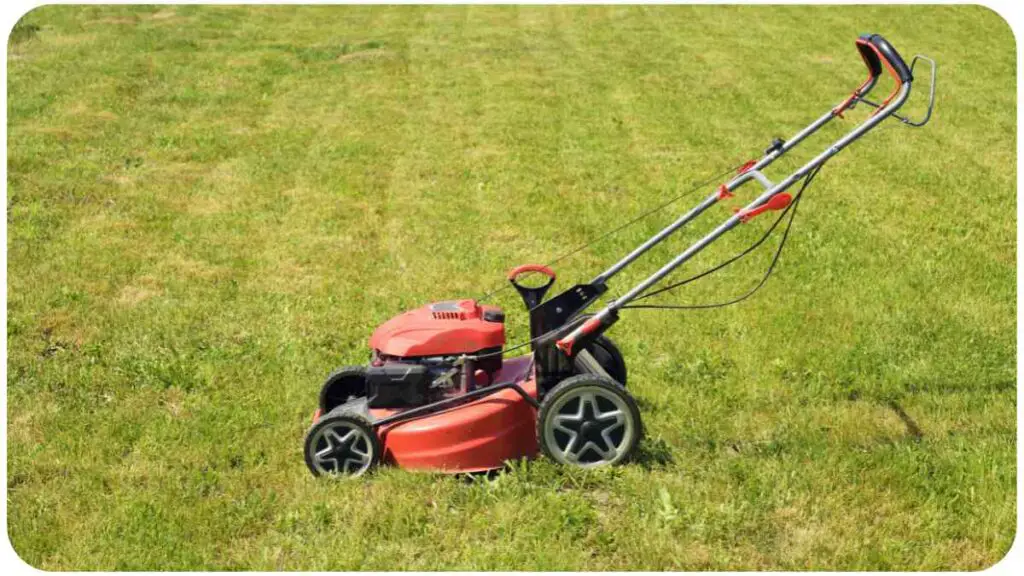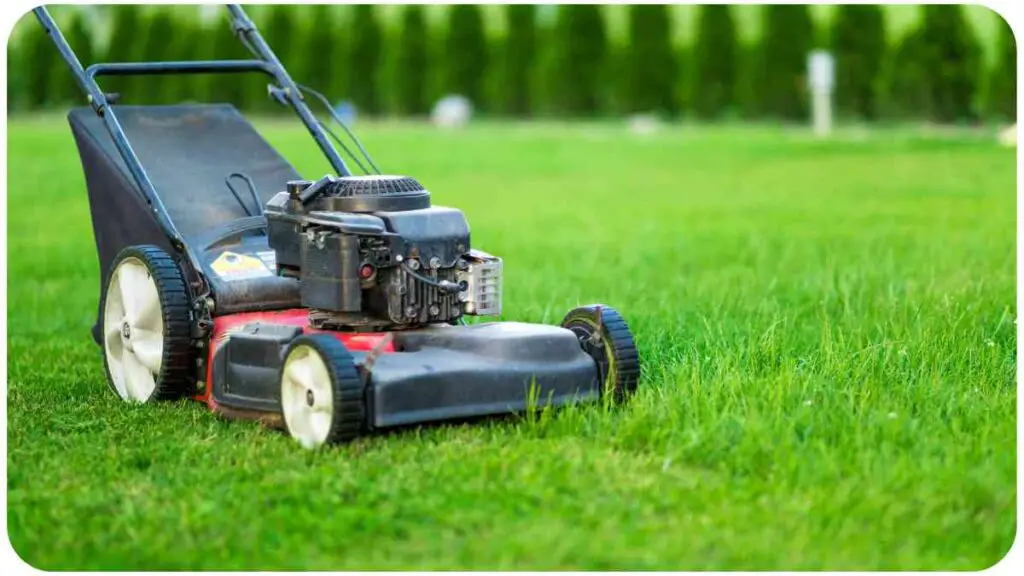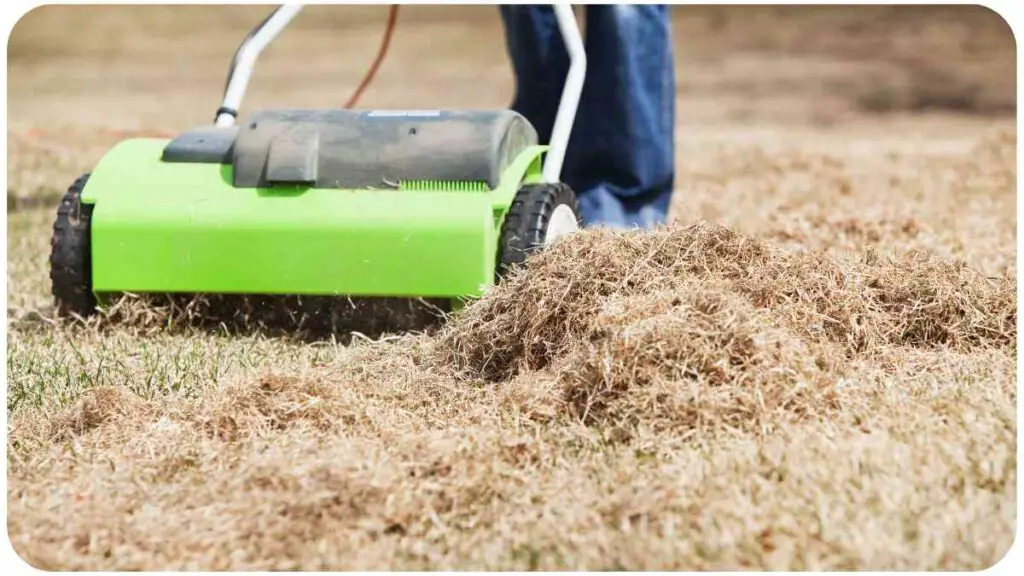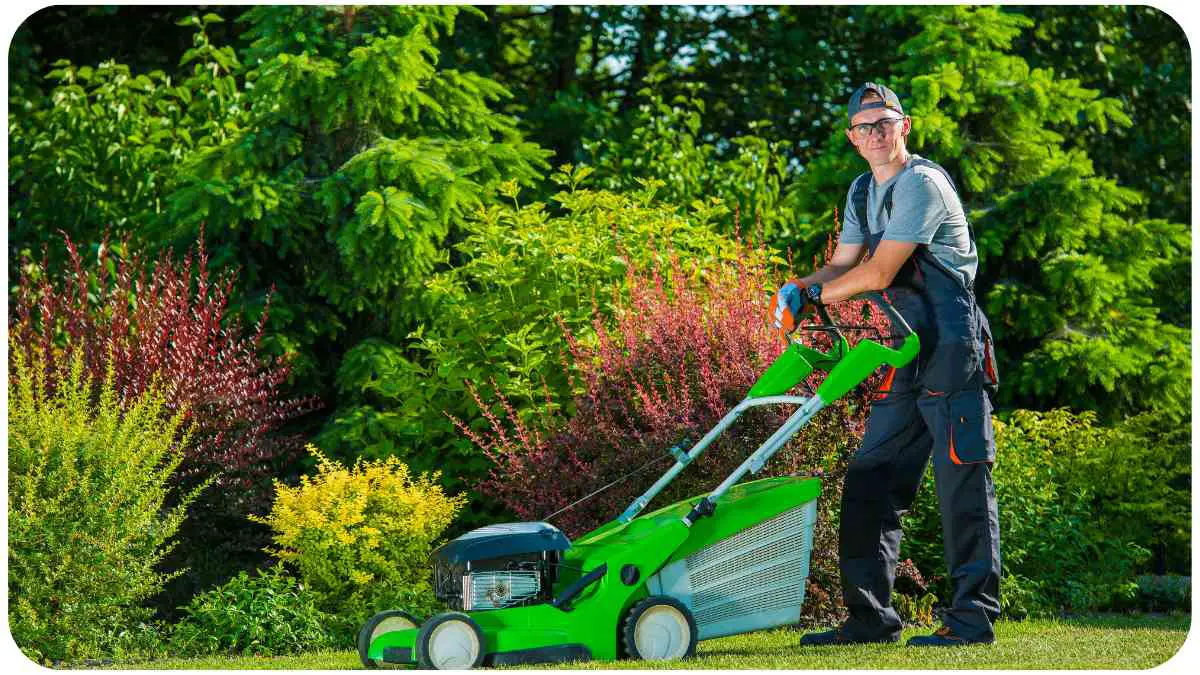Maintaining a lush, healthy lawn requires regular care, and one essential task is dethatching. But when is the best time to use a dethatcher on your lawn?
In this guide, we’ll explore the signs indicating your lawn needs dethatching, the benefits of using a dethatcher, and the optimal timing for this lawn care task.
| Takeaways |
|---|
| 1. Dethatching promotes healthier grass growth by removing thatch. |
| 2. Signs your lawn needs dethatching include sparse grass growth. |
| 3. Dethatching benefits include improved nutrient absorption. |
| 4. Timing for dethatching depends on grass type and season. |
| 5. Proper technique and equipment are essential for dethatching. |
| 6. Avoid common mistakes like overdethatching and scalping. |
| 7. Consider hiring professionals for larger or complex lawns. |
| 8. Dethatch regularly to maintain a healthy and vibrant lawn. |
2. What is a Dethatcher?
Before delving into when to use a dethatcher, let’s understand what it is. A dethatcher, also known as a power rake or vertical mower, is a gardening tool used to remove thatch a layer of dead grass, roots, and debris that accumulates on the soil surface. This thatch layer can hinder the growth of grass by preventing water, air, and nutrients from reaching the roots.
Table: Signs Your Lawn Needs Dethatching
| Signs Your Lawn Needs Dethatching |
|---|
| Sparse or patchy grass growth |
| Excessive thatch buildup |
| Water runoff instead of absorption |
| Presence of pests or diseases |
3. Signs Your Lawn Needs Dethatching

Table: Signs Your Lawn Needs Dethatching
| Signs Your Lawn Needs Dethatching |
|---|
| Sparse or patchy grass growth |
| Excessive thatch buildup |
| Water runoff instead of absorption |
| Presence of pests or diseases |
Sparse or patchy grass growth may indicate that the roots are struggling to penetrate the thatch layer to access nutrients. Additionally, if you notice an excessive buildup of thatch—typically more than half an inch thick it’s a clear sign that dethatching is necessary. When water fails to penetrate the soil and instead runs off the surface, it suggests that the thatch layer is too thick, impeding proper drainage and absorption. Furthermore, pests and diseases thrive in thatch, so if you observe an increase in pest activity or signs of disease, it may be time to dethatch your lawn.
4. Benefits of Using a Dethatcher
Dethatching offers several benefits that contribute to the overall health and appearance of your lawn.
Table: Benefits of Using a Dethatcher
| Benefits of Using a Dethatcher |
|---|
| Promotes better nutrient absorption and water penetration |
| Enhances air circulation, reducing the risk of fungal growth |
| Stimulates new grass growth and thickens existing turf |
| Improves the effectiveness of fertilizers and other treatments |
When you use a dethatcher to remove the thatch layer, you create a healthier environment for your lawn. By allowing nutrients and water to penetrate the soil more effectively, you promote stronger root development and overall grass health. Improved air circulation helps prevent fungal diseases, such as mold and mildew, which thrive in damp, stagnant conditions.
5. Best Time to Dethatch Your Lawn

Timing is crucial when it comes to dethatching your lawn. The optimal time to dethatch depends on various factors, including the type of grass you have and the climate in your region.
Table: Best Time to Dethatch Your Lawn Based on Grass Type
| Grass Type | Best Time to Dethatch |
|---|---|
| Cool-season | Early spring or early fall |
| Warm-season | Late spring or early summer |
For cool-season grasses, such as Kentucky bluegrass and fescue, the best time to dethatch is in early spring or early fall. During these seasons, the weather is cooler, and grass growth is actively transitioning, making it an ideal time to perform lawn maintenance tasks.
On the other hand, for warm-season grasses like Bermuda grass and Zoysia grass, late spring or early summer is the recommended time for dethatching. These grasses thrive in warmer temperatures and are most actively growing during the summer months.
By dethatching at the appropriate time for your grass type, you maximize the effectiveness of the process and minimize stress on your lawn.
6. How to Use a Dethatcher
Using a dethatcher is relatively straightforward, but it’s essential to follow the proper steps to ensure optimal results and avoid damaging your lawn.
To use a dethatcher:
- Adjust the dethatcher blades to the appropriate depth.
- Start at one end of the lawn and work systematically in overlapping rows.
- Avoid going too deep to prevent damaging the grass roots.
- Remove the loosened thatch with a rake or lawn sweeper.
- Water the lawn thoroughly after dethatching to promote recovery.
7. Tips for Dethatching Your Lawn
Dethatching your lawn can be a labor-intensive process, but these tips can help make it more manageable and effective:
- Check the soil moisture: Dethatch when the soil is slightly moist, but not wet, to make the process easier.
- Adjust the dethatcher depth: Set the blades to penetrate just below the thatch layer to avoid damaging the soil and grass roots.
- Use proper technique: Move the dethatcher in overlapping rows to ensure thorough coverage and avoid missing spots.
- Remove debris promptly: Rake up the loosened thatch immediately after dethatching to prevent it from suffocating the grass.
- Follow up with lawn care: After dethatching, fertilize and water your lawn to promote recovery and stimulate new growth.
By following these tips, you can dethatch your lawn effectively while minimizing the risk of damage and maximizing the benefits.
8. Common Mistakes to Avoid When Dethatching

While dethatching is a beneficial lawn care practice, there are some common mistakes to avoid to ensure successful results:
- Dethatching when the soil is too wet: Wet soil can lead to compacted clumps of thatch, making it difficult to remove and potentially damaging the grass.
- Setting the dethatcher blades too low: Adjusting the blades too low can scalp the lawn, causing damage to the grass and exposing the soil to erosion.
- Overdethatching: Removing too much thatch can stress the grass and leave it vulnerable to disease and weed infestation.
- Skipping follow-up care: After dethatching, it’s essential to follow up with proper lawn care, including fertilization and watering, to promote recovery and new growth.
By avoiding these common mistakes, you can dethatch your lawn effectively and maintain its health and vitality.
9. Equipment Needed for Dethatching
Dethatching your lawn requires the right tools to ensure proper execution and minimize the risk of damage. Here’s a list of essential equipment for dethatching your lawn:
Table: Essential Equipment for Dethatching Your Lawn
| Equipment | Description |
|---|---|
| Dethatching machine | Power tool equipped with rotating blades or tines |
| Rake | Used to remove loosened thatch from the lawn surface |
| Lawn sweeper | Helps collect and dispose of removed thatch and debris |
| Lawn aerator | Optional tool for improving soil compaction and drainage |
Investing in high-quality equipment can make the dethatching process more efficient and effective, resulting in a healthier, more beautiful lawn.
10. Hiring a Professional vs. DIY Dethatching
Deciding whether to dethatch your lawn yourself or hire a professional depends on various factors, including your experience, available time, and budget.
Table: Pros and Cons of Hiring a Professional vs. DIY Dethatching
| Hiring a Professional | DIY Dethatching | |
|---|---|---|
| Pros | – Convenience: Saves time and effort | – Cost-effective: Saves money compared to hiring a pro |
| – Expertise: Professionals have experience and skills | – Control: Allows you to oversee the process directly | |
| – Equipment: Professionals have access to specialized tools | – Learning experience: Gain knowledge and skills for future maintenance | |
| Cons | – Cost: Can be more expensive than DIY | – Time-consuming: Requires manual labor and time commitment |
| – Scheduling: Availability may be limited | – Risk of mistakes: Lack of experience may lead to errors | |
| – Dependency: Reliance on external service provider | – Equipment investment: Requires purchase or rental of tools |
Consider your preferences, resources, and the condition of your lawn when deciding whether to dethatch yourself or hire a professional.
11. Dethatching Frequency
The frequency of dethatching depends on several factors, including the grass type, soil conditions, and maintenance practices. As a general guideline:
- Cool-season grasses: Dethatch every 1-3 years as needed, typically in early spring or early fall.
- Warm-season grasses: Dethatch every 1-2 years, usually in late spring or early summer.
Observing your lawn’s condition and monitoring the buildup of thatch will help determine when it’s time to dethatch.
12. Conclusion
Dethatching is a vital aspect of lawn care that promotes healthy turf and lush, vibrant grass. By recognizing the signs indicating your lawn needs dethatching, understanding the benefits of this practice, and following best practices for dethatching and post-care, you can maintain a beautiful lawn year-round.
Whether you choose to tackle dethatching yourself or enlist the help of a professional, prioritizing this essential task will contribute to the long-term health and appearance of your lawn.
Further Reading
Here are some additional resources for further reading on lawn care and addressing common lawn issues:
- How to Help Your Lawn Repair After Grub Damage: This article provides tips on repairing your lawn after damage caused by lawn grubs, offering practical solutions for restoring its health and vitality.
- Lawn Grubs: How to Kill Them: Learn effective strategies for eliminating lawn grubs and preventing future infestations with insights from this comprehensive guide.
- Lawn Grub Control and Prevention: Discover preventive measures and control strategies for managing lawn grubs and maintaining a healthy lawn year-round.
FAQs
What are lawn grubs?
Lawn grubs are the larvae of various beetle species that feed on grassroots, causing damage to lawns.
How can I tell if my lawn has a grub infestation?
Signs of a grub infestation include brown patches of dead grass, spongy or wilting turf, and increased activity of birds and other animals digging for grubs.
What damage do lawn grubs cause?
Lawn grubs damage lawns by feeding on grassroots, which can result in thin, patchy turf, and in severe cases, complete lawn destruction.
When is the best time to treat lawn grubs?
The best time to treat lawn grubs is in late spring or early summer when they are most active and vulnerable to control measures.
What are some effective methods for controlling lawn grubs?
Effective methods for controlling lawn grubs include applying insecticides, using biological control agents such as nematodes, and maintaining proper lawn care practices to promote grass health and resilience against infestations.

Hi! My name is Hellen James, and I’m here to help you with your home-maintenance needs. Whether it’s building a better yard or just trying to fix a garden—I can show you how.


